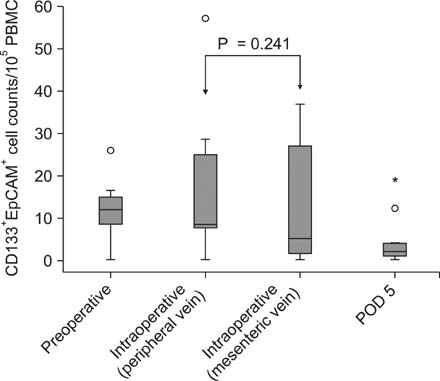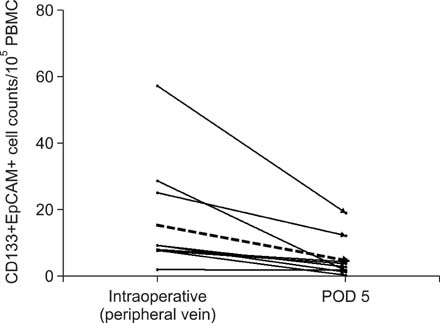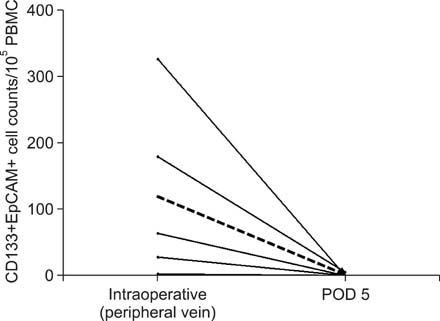Ann Surg Treat Res.
2014 Nov;87(5):232-238. 10.4174/astr.2014.87.5.232.
Comparison of putative circulating cancer stem cell detection between the hepatic portal system and peripheral blood in colorectal cancer patients
- Affiliations
-
- 1Department of Surgery, Pusan National University Yangsan Hospital, Yangsan, Korea. skm171@empas.com
- 2Research Institute for Convergence of Biomedical Science and Technology, Pusan National University Yangsan Hospital, Yangsan, Korea.
- 3Department of Physiology, Pusan National University School of Medicine, Yangsan, Korea.
- 4Department of Biochemistry, Pusan National University School of Medicine, Yangsan, Korea.
- 5Department of Laboratory Medicine, Pusan National University Yangsan Hospital, Yangsan, Korea.
- 6Department of Pathology, Pusan National University Yangsan Hospital, Yangsan, Korea.
- KMID: 2266881
- DOI: http://doi.org/10.4174/astr.2014.87.5.232
Abstract
- PURPOSE
The present pilot study was conducted to detect putative cancer stem cell (CSC) from the hepatic portal system and peripheral blood in the colorectal cancer patients and to compare them to healthy donor and diverticulitis patients.
METHODS
Laboratory study was performed to identify the expression of cell surface markers, epithelial cell adhesion molecule (EpCAM), cytokeratin (CK) 18, CK20, CD44, and CD133, on several colon cancer cell lines. Clinical pilot study was conducted to detect putative circulating CSC as EpCAM+CD133+ cell in colorectal cancer (n = 10), diverticulitis (n = 5), and four healthy donors, by using flow cytometry. Blood was drawn from the hepatic portal system and peripheral vein.
RESULTS
On laboratory study, EpCAM was expressed in whole colon cancer cell lines, and CD44 and CD133 were simultaneously expressed in 50% of the cell lines with stemness phenotype, but CK18 and CK20 were not expressed in most of the cell lines. On clinical study, the mean EpCAM+CD133+ cell counts of 11.6/105 in the hepatic portal system were somewhat lower than 15.4/105 in peripheral vein (P = 0.241). As for diverticulitis patients, EpCAM+CD133+ cells were also detected to have steeper dropped to near zero, after the surgery.
CONCLUSION
The numbers of putative CSC were not statistically different between the detection sites of the portal vein and peripheral vein in the colon cancer patients. Therefore, we may not have benefitted by getting the cells from the hepatic portal system. In addition, the CD133+EpCAM+ cells in the colon cancer patients might contain normal stem cells from cancer inflammation similar to diverticulitis.
Keyword
MeSH Terms
Figure
Reference
-
1. Allen JE, El-Deiry WS. Circulating tumor cells and colorectal cancer. Curr Colorectal Cancer Rep. 2010; 6:212–220.2. van Dalum G, Holland L, Terstappen LW. Metastasis and circulating tumor cells. J Int Fed Clin Chem Lab Med. 2012; 23:1–11.3. Pilati P, Mocellin S, Bertazza L, Galdi F, Briarava M, Mammano E, et al. Prognostic value of putative circulating cancer stem cells in patients undergoing hepatic resection for colorectal liver metastasis. Ann Surg Oncol. 2012; 19:402–408.4. Kim MY, Oskarsson T, Acharyya S, Nguyen DX, Zhang XH, Norton L, et al. Tumor self-seeding by circulating cancer cells. Cell. 2009; 139:1315–1326.5. Tsai KS, Yang SH, Lei YP, Tsai CC, Chen HW, Hsu CY, et al. Mesenchymal stem cells promote formation of colorectal tumors in mice. Gastroenterology. 2011; 141:1046–1056.6. Lugli A, Iezzi G, Hostettler I, Muraro MG, Mele V, Tornillo L, et al. Prognostic impact of the expression of putative cancer stem cell markers CD133, CD166, CD44s, EpCAM, and ALDH1 in colorectal cancer. Br J Cancer. 2010; 103:382–390.7. Vaiopoulos AG, Kostakis ID, Koutsilieris M, Papavassiliou AG. Colorectal cancer stem cells. Stem Cells. 2012; 30:363–371.8. Scatena R, Bottoni P, Giardina B. Circulating tumour cells and cancer stem cells: a role for proteomics in defining the interrelationships between function, phenotype and differentiation with potential clinical applications. Biochim Biophys Acta. 2013; 1835:129–143.9. Chen S, Song X, Chen Z, Li X, Li M, Liu H, et al. CD133 expression and the prognosis of colorectal cancer: a systematic review and meta-analysis. PLoS One. 2013; 8:e56380.10. Ren F, Sheng WQ, Du X. CD133: a cancer stem cells marker, is used in colorectal cancers. World J Gastroenterol. 2013; 19:2603–2611.11. Silinsky J, Grimes C, Driscoll T, Green H, Cordova J, Davis NK, et al. CD 133+ and CXCR4+ colon cancer cells as a marker for lymph node metastasis. J Surg Res. 2013; 185:113–118.12. Imrich S, Hachmeister M, Gires O. EpCAM and its potential role in tumor-initiating cells. Cell Adh Migr. 2012; 6:30–38.13. Munz M, Baeuerle PA, Gires O. The emerging role of EpCAM in cancer and stem cell signaling. Cancer Res. 2009; 69:5627–5629.14. Waldron NN, Barsky SH, Dougherty PR, Vallera DA. A bispecific EpCAM/CD-133-targeted toxin is effective against carcinoma. Target Oncol. 2014; 9:239–249.15. Park SY, Choi GS, Park JS, Kim HJ, Ryuk JP, Choi WH. Influence of surgical manipulation and surgical modality on the molecular detection of circulating tumor cells from colorectal cancer. J Korean Surg Soc. 2012; 82:356–364.16. Koch M, Weitz J, Kienle P, Benner A, Willeke F, Lehnert T, et al. Comparative analysis of tumor cell dissemination in mesenteric, central, and peripheral venous blood in patients with colorectal cancer. Arch Surg. 2001; 136:85–89.17. Pantel K, Deneve E, Nocca D, Coffy A, Vendrell JP, Maudelonde T, et al. Circulating epithelial cells in patients with benign colon diseases. Clin Chem. 2012; 58:936–940.18. Hardingham JE, Hewett PJ, Sage RE, Finch JL, Nuttall JD, Kotasek D, et al. Molecular detection of blood-borne epithelial cells in colorectal cancer patients and in patients with benign bowel disease. Int J Cancer. 2000; 89:8–13.19. Sato T, Vries RG, Snippert HJ, van de Wetering M, Barker N, Stange DE, et al. Single Lgr5 stem cells build crypt-villus structures in vitro without a mesenchymal niche. Nature. 2009; 459:262–265.
- Full Text Links
- Actions
-
Cited
- CITED
-
- Close
- Share
- Similar articles
-
- Clinical Utility of Portal Venous Circulating Tumor Cells in Pancreatic Cancer
- Circulating Tumor Cells and Extracellular Nucleic Acids in Breast Cancer
- Role of Liquid Biopsies in Colorectal Cancer
- A New Cell Block Method for Multiple Immunohistochemical Analysis of Circulating Tumor Cells in Patients with Liver Cancer
- Influence of surgical manipulation and surgical modality on the molecular detection of circulating tumor cells from colorectal cancer





